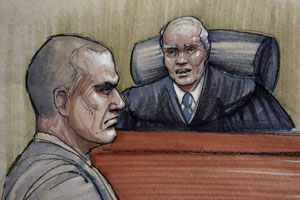
In
this courtroom sketch, David Coleman Headley, 52, left, appears before
U.S. District Judge Harry Leinenweber at federal court in Chicago,
Thursday, Jan. 24, 2013, as Leinenweber imposes a sentence of 35 years
in prison for the key role Headley played in a 2008 terrorist attack on
Mumbai. (Tom Gianni/AP Photo)
In the face of claims that the National Security Agency’s
data collection program had prevented terrorist plots, ProPublica’s Sebastian
Rotella took a
closer look at one of those: David Coleman Headley’s foiled plan to attack
a Danish newspaper. He found that, “the government
surveillance only caught up with Headley after the U.S. had been tipped by
British intelligence.” And he noted that, “Even that victory came after seven
years in which U.S.
intelligence failed to stop Headley as he roamed the globe on missions for
Islamic terror networks and Pakistan’s spy agency.”
Rotella has reported extensively on the Headley case and was a correspondent for Frontline and ProPublica’s “A Perfect Terrorist” investigation. To find out more about how authorities caught up with Headley and to discuss the intelligence gathering techniques that other international law enforcement agencies have successfully used, ProPublica editor-in-chief, Steve Engelberg, spoke with Rotella on the podcast.
Rotella has reported extensively on the Headley case and was a correspondent for Frontline and ProPublica’s “A Perfect Terrorist” investigation. To find out more about how authorities caught up with Headley and to discuss the intelligence gathering techniques that other international law enforcement agencies have successfully used, ProPublica editor-in-chief, Steve Engelberg, spoke with Rotella on the podcast.
“The lack of or limited resources foments creativity,” said
Rotella. “In other words, what several people have said in discussing this
recent brouhaha in the United States is – they almost have a sense that
the U.S. has such vast resources that it can be a hindrance and there’s such a
focus on just gathering information that it tends to hurt things like analysis
and things like knowing the world you’re trying to spy on close up. And because they have less limited
resources, they’ve been forced to get out there more on the street and develop
sources and have a lot of close-up human contact to infiltrate networks and
watch them develop and get inside them and monitor their operations.”

No comments:
Post a Comment